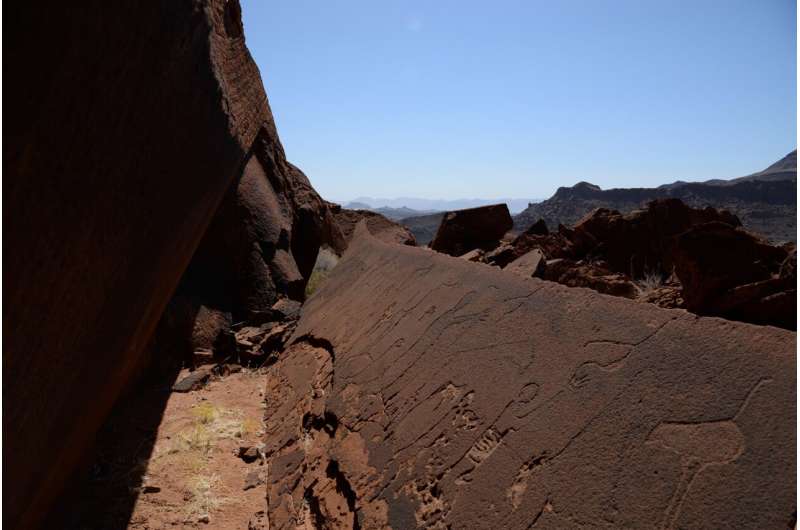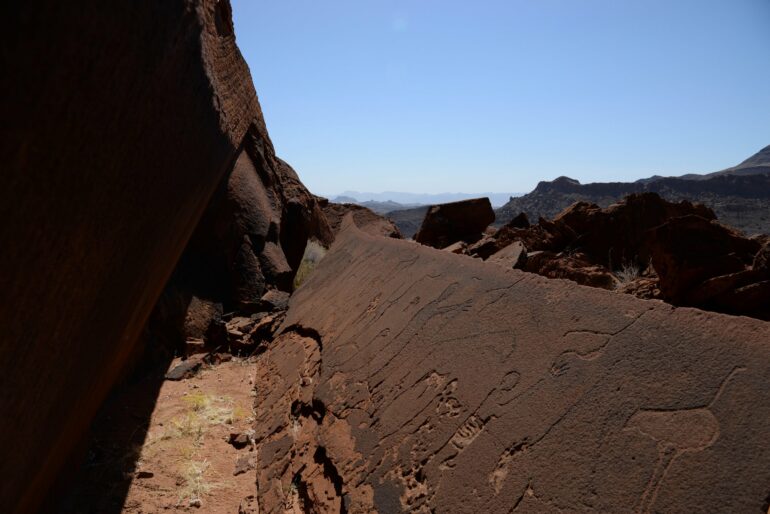During the Later Stone Age in what is now Namibia, rock artists imbued so much detail into their engravings of human and animal prints that current-day Indigenous trackers could identify which animals’ prints they were depicting, as well as the animals’ general age and sex. Andreas Pastoors of Friedrich-Alexander-Universität Erlangen-Nürnberg, Germany, and colleagues report these findings in a new study published September 13 in the open-access journal PLOS ONE.
Engravings of animal tracks and human footprints appear in numerous traditions of prehistoric rock art around the world. Namibia is especially rich in hunter-gatherer rock art from the Later Stone Age with many well-executed engravings of animal and human tracks. Most research into prehistoric rock art has grouped these engravings with geometric shapes, however, leaving them badly under-researched despite being common throughout the world.
In the new study, researchers enlisted the help of Indigenous tracking experts from the Kalahari desert to analyze animal and human footprints in rock art in the Doro Nawas Mountains in central Western Namibia. The experts were able to define the species, sex, age group and even the exact leg of the animal or human print in more than 90% of the 513 engravings they analyzed.
Their work showed the rock art had much more diversity in the animals represented by tracks than the engravings of the animals themselves. Engravers also showed a clear preference for certain species and were more likely to depict adult animals than juveniles, and male footprints compared to female footprints.
The new findings reveal patterns that likely arise from culturally determined preferences, but the meaning of these patterns is still unknown. The researchers propose that consulting with present-day Indigenous experts may shed some light in this area. They point out that while Indigenous knowledge has tremendous capacity to advance archaeological research, in this situation, the precise meaning and context of the rock art will likely remain elusive.

Stone Age animal and human depictions in Doro Nawas Mountains, Namibia. © Andreas Pastoors, CC-BY 4.0 (creativecommons.org/licenses/by/4.0/)
The authors add, “Namibia’s rock faces contain numerous Stone Age depictions of animals and humans, as well as human footprints and animal tracks. Until now, the latter have received little attention because researchers lacked the knowledge to interpret them.
“Archaeologists from the Friedrich-Alexander University of Erlangen-Nürnberg and the University of Cologne in Germany, together with indigenous trackers from the Nyae Nyae Conservancy in Tsumkwe, Namibia, have now examined several hundred of the tracks in more detail and discovered surprising details: the tracks cover a wider range of animal species than in conventional animal depictions and differentiated cultural patterns emerge in the representation of the various species.”
More information:
Animal tracks and human footprints in prehistoric hunter-gatherer rock art of the Doro Nawas Mountains (Namibia), analysed by present-day indigenous tracking experts, PLOS ONE (2023). DOI: 10.1371/journal.pone.0289560. journals.plos.org/plosone/arti … journal.pone.0289560
Provided by
Public Library of Science
Citation:
Stone Age artists carved detailed human and animal tracks in rock art in Namibia (2023, September 13)



